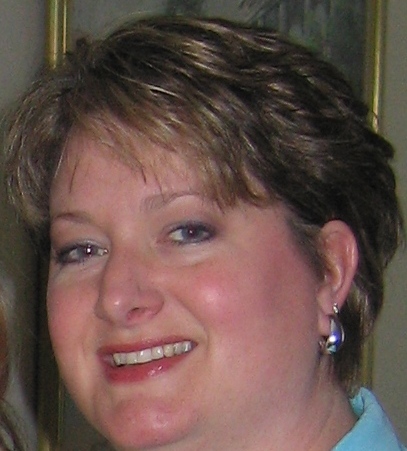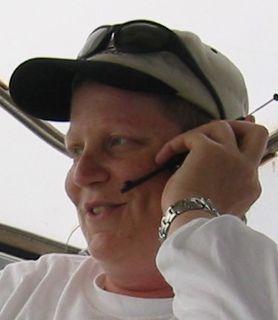I had a hard time choosing just one of the many marvelous women in tech that I might write about for Ada Lovelace Day, because, frankly, I’m surrounded by those women! Where so many think of the tech world as male-dominated, women have always played a major role at O’Reilly. A large part of our management team has always consisted of women, and women are the creators of some of our best known products and brands. I want to acknowledge their contributions, highlighting the fact that they have been so central to the success of my company. I also want to emphasize that there are many ways to contribute to a tech community, and that being a coder is not the only way to have an impact on the world of computing.
 My first hat tip has to go to my wife, Christina O’Reilly. She’s a playwright and choreographer, not a techie. But if you’ve been influenced by me, you’ve also been influenced by her. The company, its values, and much of its unusual nature have been profoundly shaped by our relationship. (You can see her influence in some of the early company documents you’ll find here,.) In more ways than I can count, I’ve built the company to be one that she would be proud of. We met when I was nineteen, and she’s been part of everything I’ve ever done, in the same way that Elizabeth Barrett Browning said of her husband, Robert Browning:
My first hat tip has to go to my wife, Christina O’Reilly. She’s a playwright and choreographer, not a techie. But if you’ve been influenced by me, you’ve also been influenced by her. The company, its values, and much of its unusual nature have been profoundly shaped by our relationship. (You can see her influence in some of the early company documents you’ll find here,.) In more ways than I can count, I’ve built the company to be one that she would be proud of. We met when I was nineteen, and she’s been part of everything I’ve ever done, in the same way that Elizabeth Barrett Browning said of her husband, Robert Browning:
What I do and what I dream include thee,
As the wine must taste of its own grapes
From the earliest years of the company, most of my key managers have been women. From 1985 till about 2000, there was a troika–Linda Walsh, Linda Lamb, and Cathy Brennan–who helped me shape the corporate culture, and for many years were touchstones for the values I still espouse.
Linda Walsh was my first employee. She helped me build my original documentation consulting business, and helped me come into my own as a leader when I broke up with my original business partner. She was also the key business leader for our digital books initiative in the late 1990s and one of the founders of Safari Books Online.
Linda Lamb was a key member of the team (along with me and Dale Dougherty) that developed our original publishing program back in 1985. Linda also served as our director of marketing for many years, with a delicious, quirky sense of humor. (I still remember one of her earliest trade show pieces, a wonderful riff on the National Enquirer, in which she reported on abductions by strange aliens with big eyes, programmers forced to participate in camel races, and exorcisms performed after errors in programming with curses.) She was also the original author of one of our first books, Learning the Vi Editor, and later creator (with Nancy Keene) of our series of Patient-Centered Guides.
I hired Cathy Brennan (now Strider) as a receptionist in 1985 or 1986, but her common sense soon made her one of my most trusted advisers and her ability to get things done made her one of my senior executives. When I decided to move to California from Boston in 1987, Cathy was the one who persuaded me to move our then-fledgling publishing business along with me, and agreed to move out herself to set up customer service and operations for this new line of business. She built and ran our operations as we grew from a tiny startup to a publishing powerhouse. She also managed the design and construction of our office complex in Sebastopol.
 Laura Baldwin joined the company as CFO in 2001, just as we were crashing into the wall of the dot com bust. I can with confidence say that we wouldn’t have survived without her. I had always held up Harold, the last of the Saxon kings of England, as one of my management heroes. He went down to defeat by William the Conqueror rather than abandon his people to fight another day. Laura convinced me that I needed to do layoffs–and when I did, I found that the people we laid off moved on to what were often better jobs for them, and the company itself became leaner, more creative, and more effective. Laura brought financial discipline to the company. She helped bring us back from the brink, and built a bigger, more profitable, and more successful company. Living to fight another day helped us to birth the Web 2.0 movement, Foo Camp, Make: magazine, the Missing Manuals, and many of the other post-2001 products we are known for today.
Laura Baldwin joined the company as CFO in 2001, just as we were crashing into the wall of the dot com bust. I can with confidence say that we wouldn’t have survived without her. I had always held up Harold, the last of the Saxon kings of England, as one of my management heroes. He went down to defeat by William the Conqueror rather than abandon his people to fight another day. Laura convinced me that I needed to do layoffs–and when I did, I found that the people we laid off moved on to what were often better jobs for them, and the company itself became leaner, more creative, and more effective. Laura brought financial discipline to the company. She helped bring us back from the brink, and built a bigger, more profitable, and more successful company. Living to fight another day helped us to birth the Web 2.0 movement, Foo Camp, Make: magazine, the Missing Manuals, and many of the other post-2001 products we are known for today.
Laura is now our COO as well as CFO, and is the day-to-day manager of the business. Those of you who wonder how I find so much <a href=http://twitter.com/timoreillytime to spend on twitter while running a business, look no further!
I have learned more about the nuts and bolts of business from Laura than from any other person. Harold Geneen once said “The skill of management is to achieve your objectives through the efforts of others.” Laura knows how to do that in spades – she’s a great manager. But she’s also the most amazingly productive person I’ve ever met. Usually, you have to choose between an effective manager and an effective individual contributor. Laura somehow manages to be both.
 The list goes on. CJ Rayhill was our CIO for seven years, working with Laura to build the information systems that turned O’Reilly into a “real company.” (She was also one of the first women to graduate from the Naval Academy – here’s an interview about her history in the tech industry.) She’s now the COO for Safari Books Online, where she’s managing the extremely cool features that will be appearing in Safari 6.0 later this year.
The list goes on. CJ Rayhill was our CIO for seven years, working with Laura to build the information systems that turned O’Reilly into a “real company.” (She was also one of the first women to graduate from the Naval Academy – here’s an interview about her history in the tech industry.) She’s now the COO for Safari Books Online, where she’s managing the extremely cool features that will be appearing in Safari 6.0 later this year.
Gina Blaber was the original managing editor for GNN, the world’s first commercial website. She then ran our software group (remember Website Pro, the first PC-based web server?) and now runs the O’Reilly Conferences group. If you’ve ever been to an O’Reilly event, it’s easy to think that the speakers and program chairs do all the work, forgetting that it’s Gina and her team (mostly women) who make it all look so easy.
Laurie Petrycki ran several of our publishing divisions (notably Head First and Missing Manuals) before taking on the challenge last year of launching our new education division.
And that’s leaving out the many women who’ve worked as editors, copyeditors, designers, and production staff at O’Reilly over the years. If you’ve ever read and enjoyed an O’Reilly book, take a moment to appreciate how many hands, how many eyes, read it before you did, to shape it into its final form.
Sara Winge is the creator of Foo Camp, one of O’Reilly’s quirkiest and most influential initiatives. While Wikipedia claims me as a co-creator of the event, I have to say that it has always really been Sara’s brainchild. I had wanted to do some kind of events at O’Reilly after the dot com bust left us with a lot of unused space, and I might have even proposed residential events, but Sara is the one who picked up this idea from the heap where we tend to leave good ideas that don’t have anyone to make them real.
Sara conceived and developed the format (inspired in part by Open Space, she says, but to my mind, all the best parts were original.) I’ve just been the front-man and impresario. So if you’ve been to Foo Camp, or to Bar Camp, or any of the many other “Camp” spinoffs, you owe a big round of thanks to Sara. Foo Camp also demonstrates a uniquely feminine sensibility. Sara didn’t charge to the front; she created a context where other people can shine, quietly facilitating. As Lao Tzu said, “When the best leader leads, the people say, ‘We did it ourselves.'”
Edie Freedman is the creator of the distinctive O’Reilly animal brand. Many people know a bit about the story of how strange animals came to be the symbols of so many technologies, but what they probably don’t know that behind this brand, so central to the company’s heritage, was an act of generosity by a complete stranger.
Our first books, published late in 1985, all had the same simple cover, featuring the image of a nutshell. The idea was that these small books had everything you needed, in a nutshell. In 1987, with seven books in print, we realized that people at trade shows weren’t recognizing that we had more than one book, so we hired a designer to produce some new covers. She developed a treatment that was colorful, geometric and high-tech. We had an all-hands meeting on a Friday afternoon to review the new cover treatment. I just couldn’t go for it. It was too expected. I said we’d have to try again.
 Linda Lamb shared our plight with her housemate, Edie, who at the time was a designer at Digital Equipment Corporation. Edie thought that Unix program names sounded like weird animals. She also realized that 19th century woodcuts provided a unique, low-cost design option. Fair enough. But she went further than that. She produced and laid out seven mechanicals of possible covers over the weekend. Linda brought them in on Monday, free of charge. Here’s one of the original designs, for Sed & Awk, a book that didn’t even exist yet.)
Linda Lamb shared our plight with her housemate, Edie, who at the time was a designer at Digital Equipment Corporation. Edie thought that Unix program names sounded like weird animals. She also realized that 19th century woodcuts provided a unique, low-cost design option. Fair enough. But she went further than that. She produced and laid out seven mechanicals of possible covers over the weekend. Linda brought them in on Monday, free of charge. Here’s one of the original designs, for Sed & Awk, a book that didn’t even exist yet.)
How cool is that? One of the great brands in tech was a gift from a stranger! (Edie did later come to work for us, and served as our Creative Director for many years. She is still with the company.) That is one of the many experiences that made me receptive to the idea of open source as a gift culture when Eric Raymond wrote about that in 1997.
(While I’m on the subject of the kindness of strangers, I have to call out the contributions of Danese Cooper and Linda Stone, two people who’ve never worked for O’Reilly but who might as well have done, for all the tireless work they do on our behalf. I met Danese through our mutual work on open source when she was the “open source diva” at Sun, and later at Intel. She’s the person I always call when anyone asks me for advice on open source licensing, community, or corporate adoption. Linda Stone, former maven at Apple and Microsoft, is a mentor and inspiration on the value of making connections between people who ought to know each other. Linda is also the one who had the brilliant idea of Science Foo Camp when Timo Hannay of the Nature Publishing Group and I were scratching our heads trying to find a project to do together. She’s also the one who suggested we ask Google to host the party. Never mind random acts of kindness; there’s real power in random acts of connection. When I said a few years back that our purpose at Foo Camp is to create new synapses in the global brain, I was channeling what I learned from Linda.)
I could go on and on. There’s Allison Randal, who Nat Torkington already wrote about in his own Ada Lovelace Day post earlier today. There’s Kathy Sierra, the creator of the amazing Head First series of books, and also the subject of many another Ada Lovelace Day post. There’s Carla Bayha, who for many years was the computer book buyer at Borders, and whose penetrating judgment helped books on many an obscure topic find space on shelves across America. Carla is truly an unsung hero of the industry.
And of course, I celebrate the many other women authors, conference speakers, and coders who’ve been a part of O’Reilly’s story over the years. Truly, we could never have done it without you. As far as I’m concerned, it’s always Ada Lovelace Day at O’Reilly.
